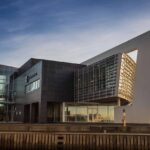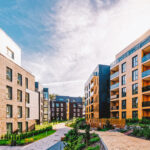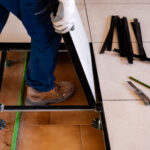In recent years, workplaces have undergone a considerable transformation, with an increased focus on versatility, comfort and efficiency. This evolution has led to the adoption of innovative design solutions for offices and modern research studies, including the use of ventilated façades and porcelain stoneware raised flooring.
But how do these systems integrate and meet modern-day demands, contributing to the creation of state-of-the-art, high-performance workspaces?
Practicality and flexibility: offices must move with the times
There is a strong connection between society and architecture and social transformations involve a continuous adaptation and evolution process in work environments as well. The dynamics triggered by the pandemic have transformed the spaces set aside for working and, nowadays, offices are conceived as multi-functioning spaces for multi-purpose activities: the environments can be easily changed for fast and continuous re-arranging to meet the evolving needs of professionals who require privacy, concentration or need to share, depending on the activities carried out. Similarly, essential factors like energy efficiency and environmental sustainability should not be overlooked.
This is where state-of-the-art solutions like ventilated façades and raised porcelain stoneware flooring slot in.

Raised flooring and ventilated façades for the offices of the future
The combined use of porcelain stoneware ventilated façades and raised flooring offers a complete solution for current-day and future offices. The combined use of these systems not only provides an excellent thermal and energy control, but also creates flexible, comfortable workspaces.
The modularity offered by raised flooring allows for rapid adaptability to spaces, making it easier to create collaborative and stimulating environments. Equally, porcelain stoneware ventilated façades provide offices with a modern, sustainable look, contributing to the well-being of its occupants and the overall energy efficiency. Some of the features of porcelain stoneware and other advantages of raised flooring and ventilated façades for use in work places include:
- Breathability and steady, even heat insulation, essential factors for offering maximum comfort throughout the year to those who spend their days in professional environments;
- Sound insulation is an essential condition in any kind of office, with the subsequent reduction of the noise of footsteps and the service systems;
- An opportunity to replace and reposition the individual tiles or even re-arrange the layout of the interiors;
- Simple inspection of all the service systems, thanks to the possibility of positioning them under the treadable surface of the porcelain stoneware raised flooring;
- Extremely quick, simple installation, cleaning and maintenance;
- Sophisticated design and fully bespoke, because appearance is what catches the eye first in any company. One of the main features of porcelain stoneware is that it is available in a wide range of colours, finishes and textures and precisely this aesthetic flexibility allows the look of an office to be adapted to the needs and desired style to reflect the company’s image;
- Porcelain stoneware raised flooring is resistant and long-lasting, guaranteeing a flooring capable of remaining unaltered over time, even in areas with a lot of coming and going, like work environments;
- Environmental sustainability, thanks to the use of a green material like porcelain stoneware.
Ventilated façades and porcelain stoneware raised flooring: a welcoming office encourages productivity
Comfort, flexibility and energy efficiency are key elements in offices and in every modern work environment. The adoption of solutions like ventilated façades and porcelain stoneware raised flooring is a step towards ever more sustainable, state-of-the art work places. These systems not only improve the performance of buildings, but also contribute to creating advanced, welcoming environments, promoting workers’ well-being and productivity.



